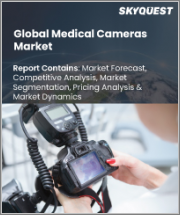
의료용 카메라 세계 시장 규모는 2023년 33억 달러, 2024년 35억 4,000만 달러에서 2032년에는 62억 7,000만 달러로 성장하고, 예측 기간(2025-2032년)의 CAGR은 7.4%를 나타낼 전망입니다.
헬스케어 분야에서의 영상진단 수요의 급증은 의료용 카메라의 매출을 크게 끌어올릴 것으로 보입니다. 원격 의료 및 원격 진료의 보급은 의료용 카메라 시장을 더욱 확대시킬 가능성이 높습니다. 센서와 카메라 기술의 혁신으로 제조업체들은 기능성과 특징을 강화한 제품을 출시할 수 있을 것으로 예측됩니다. 또한, 전 세계적으로 저침습 수술에 대한 선호도가 높아지는 것도 매출 증가에 도움이 될 것으로 보입니다. 한편, 헬스케어 인프라에 대한 투자 증가는 의료용 카메라 제조업체들에게 새로운 길을 열어줄 것으로 예측됩니다. 그러나 첨단 기술의 높은 비용, 빠른 노후화, 제한된 의료 예산, 숙련된 전문가 부족 등의 문제는 진화하는 시장 환경에서 의료 서비스 제공업체에게 장애물이 될 수 있습니다.
Global Medical Cameras Market size was valued at USD 3.3 billion in 2023 and is poised to grow from USD 3.54 billion in 2024 to USD 6.27 billion by 2032, growing at a CAGR of 7.4% during the forecast period (2025-2032).
The surging demand for diagnostic imaging within the healthcare sector is set to significantly boost medical camera sales. The growing embrace of telemedicine and remote care is likely to further enhance the market for medical cameras. Innovations in sensor and camera technologies are expected to empower manufacturers to introduce products with enhanced functionalities and features. Additionally, the escalating preference for minimally invasive surgeries globally will drive sales as well. Meanwhile, increased investments in healthcare infrastructure are projected to open new avenues for medical camera companies. However, challenges such as the high costs of advanced technologies, rapid obsolescence, limited healthcare budgets, and a shortage of skilled professionals may act as obstacles for providers in this evolving market landscape.
Top-down and bottom-up approaches were used to estimate and validate the size of the Global Medical Cameras market and to estimate the size of various other dependent submarkets. The research methodology used to estimate the market size includes the following details: The key players in the market were identified through secondary research, and their market shares in the respective regions were determined through primary and secondary research. This entire procedure includes the study of the annual and financial reports of the top market players and extensive interviews for key insights from industry leaders such as CEOs, VPs, directors, and marketing executives. All percentage shares split, and breakdowns were determined using secondary sources and verified through Primary sources. All possible parameters that affect the markets covered in this research study have been accounted for, viewed in extensive detail, verified through primary research, and analyzed to get the final quantitative and qualitative data.
Global Medical Cameras Market Segments Analysis
Global Medical Cameras Market is segmented by Type, Sensor, Resolution, End User and region. Based on Type, the market is segmented into Endoscopy Cameras, Surgical Microscopy Cameras, Ophthalmology Cameras, Dermatology Cameras, Dental Cameras and Other Medical Cameras. Based on Sensor, the market is segmented into CMOS Sensors and CCD Sensors. Based on Resolution, the market is segmented into High-Definition Cameras and Standard-Definition Cameras. Based on End User, the market is segmented into Hospitals & Ambulatory Surgery Centers and Specialty Clinics. Based on region, the market is segmented into North America, Europe, Asia Pacific, Latin America and Middle East & Africa.
Driver of the Global Medical Cameras Market
The global medical cameras market is being propelled by significant investments in imaging technology advancements, which have led to the development of superior cameras featuring enhanced clarity and resolution. As a result, these technological improvements are elevating the performance of medical cameras, enabling healthcare professionals to detect and diagnose medical conditions with greater accuracy and efficiency. This trend is anticipated to drive an increase in the sales of advanced medical cameras in the coming years, reflecting the growing demand for precision in medical imaging and diagnostic processes within the healthcare industry.
Restraints in the Global Medical Cameras Market
The Global Medical Cameras market faces significant challenges due to the high costs associated with cutting-edge technologies and sensors integrated into advanced medical cameras. These sophisticated devices come with a hefty price tag, making them inaccessible for many healthcare facilities that may lack the financial resources to invest in such expensive equipment. As a result, the prohibitive costs are likely to hinder the growth and overall outlook of the medical cameras market in the foreseeable future, limiting the adoption of these advanced solutions in various healthcare settings. This financial barrier poses a crucial restraint on market expansion and innovation.
Market Trends of the Global Medical Cameras Market
The Global Medical Cameras market is witnessing a significant trend towards the adoption of 3D and 4K imaging technologies, driven by the demand for superior diagnostic accuracy and enhanced surgical precision. These advanced imaging solutions offer remarkable depth perception and visual clarity, positioning themselves as essential tools in modern healthcare applications. As healthcare providers increasingly recognize the benefits of high-definition imaging, the integration of 3D and 4K cameras is likely to become a cornerstone of clinical practice. This shift not only augments traditional imaging methodologies but also paves the way for innovative procedures and improved patient outcomes across various medical specialties.